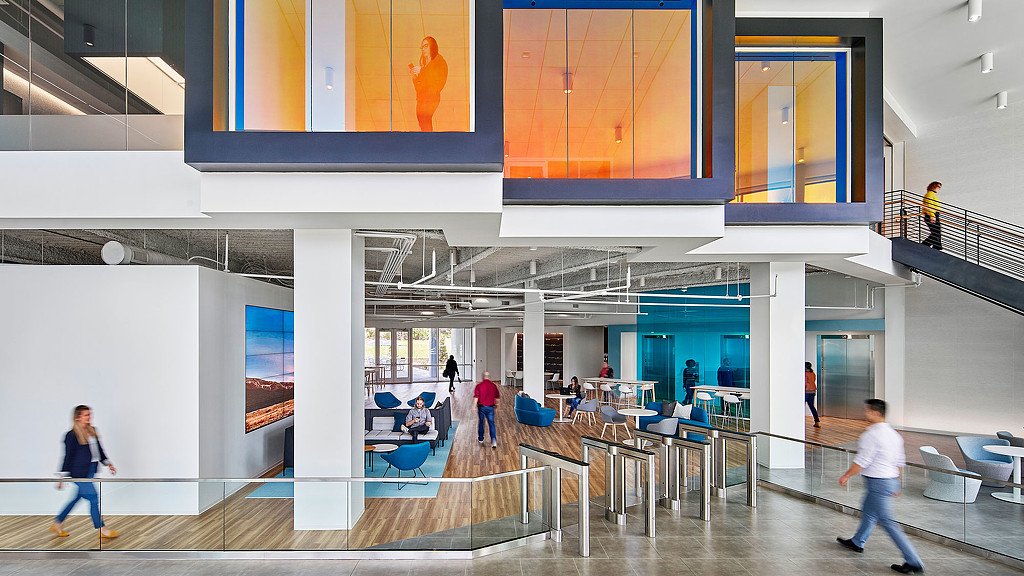Why Inclusive Design Is a Critical Advantage in the War for Talent
December 02, 2021 | By Gail Napell
Across industries, companies are planning changes in the workplace to ensure that their employees feel safe and supported. For these companies and others who are looking to compete in the war for talent by delivering a positive employee experience, inclusive design is a critical consideration. Inclusive design helps our clients open the door to an untapped labor pool without placing undue focus on individual needs. When an environment is created through the lens of inclusive design, the company can focus on creating an inclusive culture with appropriate policies that help to foster diversity and inclusion, which ultimately results in a more profitable and healthier workforce.
Inclusive design for all people incorporates design solutions that meet needs related to gender identity, race, ability, age, neurodiversity, socioeconomic status, and culture. It is considerate of the ways in which these needs intersect and creates environments that are convenient and comfortable for everyone. Inclusive design includes seamless environments that create equitable, engaging, and inspiring experiences for all, boosting performance and helping to attract and retain the best talent.
The built environment has a part to play in removing, reducing, or mitigating experiences of exclusion from the everyday lived experiences of all people who use space. By designing spaces in which everyone is considered the intended occupant, we may help to cultivate the conditions for broader experiences of inclusion, equity, and belonging.
Inclusive design means creating a work environment that’s comfortable and flexible for all, where you design for the reality that comfort will mean something different to each individual person. Creating a comfortable and flexible environment can develop the conditions where employees feel supported in bringing their whole self to the company.
Reducing barriers within the workplace
The built environment plays a role in removing, reducing, and mitigating experiences of exclusion within the workplace — where environments are not inclusive, employees will not feel supported in these spaces.
Barriers within the built environment are one of many moments of exclusion a person may experience in their day. While it is difficult to define inclusion in the workplace, just about everyone knows what it's like to experience exclusion. Inclusive design aims to ensure barriers to inclusion are not a result of the built environment.
According to a Harvard Business Review survey, here are some key findings on the value of inclusion and belonging at work:
- 40% of people say they feel isolated at work and the result of that isolation is lower organizational commitment and engagement.
- Exclusion is damaging because it actually hurts — the sensation is akin to physical pain.
- High belonging is linked to 56% increase in job performance, 50% decrease in turnover risk, and a 75% reduction in sick days (a 10,000-person company would result in an annual savings of $52 million).
- Employees with higher workplace belonging showed a 167% increase in employer promoter score.
In a previous blog post, we outlined some inclusive design strategies to make the return to work accessible — from creating more accessible entrances and security to clear wayfinding, signage, and graphics. It’s clear that these design adjustments can yield big dividends without major costs or overhauls.
Here are four key benefits for creating an inclusively designed workplace:
1. Inclusive companies are 1.7x more innovative. Companies that are diverse and encourage inclusion aren’t just more likely to outperform competitors, they're also almost twice as likely to be leaders of innovation in their industries.
2. Inclusive companies are more profitable. Inclusive companies generate significantly more cash flow per person as each employee has greater buy-in to the company’s culture and missions.
3. Inclusively designed environments allow companies to attract and retain the best talent. Inclusively designed environments allow for hiring professionals to attract and retain the right candidates for the position without having to consider barriers that exist in the built environment.
4. Employees tend to be more productive and satisfied when they have a variety of workspace types to choose from, depending on the type of task they are engaged in. Research from Gensler’s global workplace surveys confirm this finding.
By removing barriers, space can help remove stigmas and increase choice while giving the tools to help employees succeed. By creating spaces that allow all employees to feel safe and comfortable enough to thrive, regardless of their ability or workstyle, companies can create a more inclusive culture, a healthier environment, and a more productive workplace.
For media inquiries, email .
